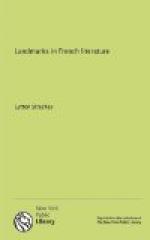There can be little doubt that if the development of fiction had stopped at this point the infusion into it of the romantic spirit could only have been judged a disaster. From the point of view of art, such novels as those of Victor Hugo and the early works of George Sand were a retrogression from those of the eighteenth century. Manon Lescaut, tiny, limited, unambitious as it is, stands on a far higher level of artistic achievement than the unreal and incoherent Les Miserables. The scale of the novel had indeed been infinitely enlarged, but the apparatus for dealing adequately with the vast masses of new material was wanting. It is pathetic to watch the romantic novelists trying to infuse beauty and significance into their subjects by means of fine writing, lyrical outbursts, impassioned philosophical dissertations, and all the familiar rhetorical devices so dear to them. The inevitable result was something lifeless, formless, fantastic; they were on the wrong track. The true method for the treatment of their material was not that of rhetoric at all; it was that of realism. This fact was discovered by STENDHAL, who was the first to combine an enlarged view of the world with a plain style and an accurate, unimpassioned, detailed examination of actual life. In his remarkable novel, Le Rouge et Le Noir, and in some parts of his later work, La Chartreuse de Parme, Stendhal laid down the lines on which French fiction has been developing ever since. The qualities which distinguish him are those which have distinguished all the greatest of his successors—a subtle psychological insight, an elaborate attention to detail, and a remorseless fidelity to the truth.




